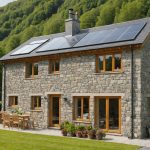Top Low-Light Indoor Plants to Improve Air Quality in Your UK Apartment
When it comes to enhancing the air quality and aesthetic appeal of your UK apartment, incorporating low-light indoor plants is an excellent strategy. These plants not only thrive in conditions with limited natural light but also offer numerous health benefits, from purifying the air to reducing stress and improving sleep quality.
Why Choose Low-Light Indoor Plants?
In many UK apartments, especially those with limited window space or north-facing rooms, natural light can be scarce. However, this doesn’t mean you have to forgo the benefits of having plants in your home. Low-light indoor plants are designed to flourish in these conditions, making them perfect for any room, regardless of the light availability.
A lire aussi : Top Wall Insulation Solutions for 1950s UK Brick Homes: Discover the Best Materials
Improved Air Quality
Indoor plants act as natural air filters, removing toxins and pollutants from the air and releasing oxygen. This can significantly improve indoor air quality, leading to better respiratory health and more refreshing sleep.
“As indoor plants absorb carbon dioxide and release oxygen, they help in maintaining a healthy balance of gases in the air,” explains a horticultural expert. “This is particularly beneficial in urban environments where air pollution is a significant concern.”
Lire également : Essential Factors to Consider When Creating an Emergency Shelter in Your UK Suburban Home
Reduced Stress and Anxiety
The presence of greenery has a calming effect on the mind. Indoor plants can help reduce stress levels, promote relaxation, and create a tranquil atmosphere in your living room or bedroom.
“Having plants around can make a room feel more welcoming and peaceful,” says a homeowner who has incorporated several low-light plants into her apartment. “It’s amazing how a simple plant can transform the ambiance of a space.”
Better Sleep
Certain indoor plants release oxygen at night, making them ideal for bedrooms. Increased oxygen levels can improve sleep quality, leaving you feeling more refreshed and energized in the morning.
Best Low-Light Indoor Plants for Air Purification
Here are some of the top low-light indoor plants known for their air-purifying properties and ease of care.
1. Snake Plant (Sansevieria)
- Light: Low to bright indirect light
- Watering: Infrequent watering, allowing soil to dry between waterings
- Toxicity: Non-toxic to pets
- Air Purification: Effective in removing formaldehyde, benzene, and trichloroethylene from the air
The snake plant is one of the most resilient and low-maintenance houseplants. It can thrive in almost any light condition and requires minimal watering, making it perfect for busy individuals.
2. Spider Plant (Chlorophytum comosum)
- Light: Bright indirect to low light
- Watering: Regular watering, keeping soil consistently moist
- Toxicity: Non-toxic to pets
- Air Purification: Removes air pollutants like formaldehyde and xylene
Spider plants are easy to grow and can be propagated easily by dividing the plantlets that grow on the ends of their stems. They are great for hanging baskets or pots and can survive in a variety of light conditions.
3. Peace Lily (Spathiphyllum)
- Light: Low to bright indirect light
- Watering: Moderate watering, allowing soil to dry slightly between waterings
- Toxicity: Toxic to pets if ingested
- Air Purification: Effective in removing ammonia, benzene, and trichloroethylene from the air
Peace lilies are known for their elegant white blooms and ability to purify the air. However, they should be kept out of reach of pets due to their toxicity.
4. English Ivy (Hedera helix)
- Light: Bright indirect to low light
- Watering: Once a week, keeping soil moist but not soggy
- Toxicity: Toxic to pets if ingested
- Air Purification: Removes air pollutants like benzene, formaldehyde, and trichloroethylene
English ivy is a versatile plant that can be trained to climb or left to trail. It prefers high humidity and can thrive in bathrooms or kitchens.
5. Parlor Palm (Chamaedorea elegans)
- Light: Bright indirect to low light
- Watering: Every one to two weeks, keeping soil moist but not soggy
- Toxicity: Non-toxic to pets
- Air Purification: Removes air pollutants like benzene and trichloroethylene
Parlor palms are resilient and can adapt to various light conditions. They prefer well-drained soil and moderate humidity.
Detailed Comparison of Top Low-Light Indoor Plants
Here is a comprehensive table comparing some of the best low-light indoor plants for air purification and ease of care:
| Plant Name | Light Requirements | Watering Needs | Toxicity to Pets | Air Purification Capabilities |
|---|---|---|---|---|
| Snake Plant | Low to bright indirect | Infrequent | Non-toxic | Formaldehyde, benzene, trichloroethylene |
| Spider Plant | Bright indirect to low | Regular | Non-toxic | Formaldehyde, xylene |
| Peace Lily | Low to bright indirect | Moderate | Toxic | Ammonia, benzene, trichloroethylene |
| English Ivy | Bright indirect to low | Once a week | Toxic | Benzene, formaldehyde, trichloroethylene |
| Parlor Palm | Bright indirect to low | Every 1-2 weeks | Non-toxic | Benzene, trichloroethylene |
| Stromanthe Triostar | Low to medium light | Every 2 weeks | Non-toxic | Formaldehyde, xylene |
| Maranta Red Prayer | Low to medium light | Once a week | Non-toxic | Formaldehyde, benzene |
| Wax Plant | Bright indirect to low | Once a week | Non-toxic | Formaldehyde, benzene |
Practical Care Tips for Your Low-Light Indoor Plants
To ensure your low-light indoor plants thrive, here are some practical care tips:
Watering
- Check the Soil: Before watering, always check the moisture level of the soil by inserting your finger into the soil up to the first knuckle. This helps prevent overwatering, which can lead to root rot.
- Water Thoroughly: When you do water your plants, make sure to water them thoroughly until water drains out of the bottom of the pot.
Humidity
- Maintain Humidity: Many low-light plants prefer high humidity, especially those like the parlor palm and maranta red prayer plant. You can increase humidity around your plants by placing the pot on a tray filled with water and pebbles or using a humidifier.
- Avoid Dry Air: Dry air can be detrimental to plants, especially during the winter months when heating systems are in use. Ensure your plants are not placed near heating vents or radiators.
Lighting
- Optimize Light: While these plants can tolerate low light, they still benefit from some indirect sunlight. Place them near a north-facing window or use grow lights if natural light is scarce.
- Avoid Direct Sunlight: Direct sunlight can be too intense for low-light plants and may cause the leaves to become scorched.
Soil and Fertilization
- Use Well-Drained Soil: Ensure the potting soil is well-drained to prevent waterlogged soil, which can lead to root rot.
- Fertilize Sparingly: Feed your plants with a balanced fertilizer during the growing season (spring and summer). Dilute the fertilizer to half the recommended strength to avoid burning the roots.
Aesthetic and Functional Benefits
In addition to their air-purifying properties, low-light indoor plants can also enhance the aesthetic appeal of your home.
Natural Decor
- Add Greenery: Indoor plants can add a touch of natural beauty to any room, creating a soothing and welcoming atmosphere.
- Versatile Placement: From hanging baskets to floor-standing pots, there are numerous ways to display your plants, making them versatile decor pieces.
Health Benefits
- Improved Sleep: By releasing oxygen at night, some plants like the peace lily can help improve sleep quality.
- Reduced Stress: The presence of plants has been shown to reduce stress levels and promote relaxation, making them ideal for bedrooms and living rooms.
Incorporating low-light indoor plants into your UK apartment is a simple yet effective way to improve air quality, enhance the aesthetic appeal of your space, and promote better health and well-being. By choosing the right plants and following simple care tips, you can enjoy the numerous benefits these plants offer.
“Having low-light plants in my apartment has made a significant difference in the air quality and overall ambiance of my home,” says a satisfied homeowner. “It’s a small investment that pays off in many ways.”
Whether you’re a seasoned gardener or a beginner, these plants are easy to care for and can thrive in even the most challenging light conditions. So, go ahead and bring some greenery into your home – your air quality, and your well-being, will thank you.











